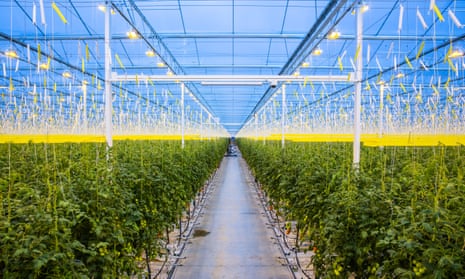People in Britain will soon be able to feast on tomatoes grown with the help of a water treatment plant in what backers say is a world first.
One of the UK’s largest clean energy funds has revealed plans to invest £120m in a pair of low-carbon greenhouses in Norfolk and Suffolk, in eastern England, large enough to grow 10% of the UK’s homegrown tomato crop.
The giant greenhouses – each one is one-and-a-half times the size of the O2 in London – will be used to grow up to 20 tonnes of tomatoes a day using the heat from Anglian Water’s water treatment facilities.
The 7-metre tall glass structures will allow crops to grow vertically along guide wires. They will grown hydroponically from nutrient-rich water solutions instead of using soil.
The scheme will require the UK’s largest heat pumps, which will channel heat from warm water into the greenhouses to help speed growth, before returning cool water back to the river system.
The carbon emissions from an on-site electricity plant will also be funnelled into the greenhouses for the plants to absorb.
Greencoat Capital, the fund behind the world-first plans, estimates that the greenhouses will produce vegetables with a quarter of the carbon footprint of regular greenhouses. It could also create 360 permanent jobs in the area, and up to 460 at peak season, it said.
Greencoat plans to start construction immediately and begin growing its crops by the autumn of 2020.
James Samworth, a partner at the fund, said Greencoat saw “considerable opportunity” to invest in renewable heat in the UK. This could help generate stable returns for its pension fund clients while helping to reduce carbon emissions as the UK worked to become a carbon neutral economy by 2050, he said.
The concept for the greenhouse project was created by British developer, Oasthouse Ventures, to help reduce emissions from the agriculture sector, which is considered a “hard to treat” area of the UK’s carbon-cutting agenda.
Other developers also plan to use renewable heat from power plants, factories or underground geothermal stores to help cut emissions.







